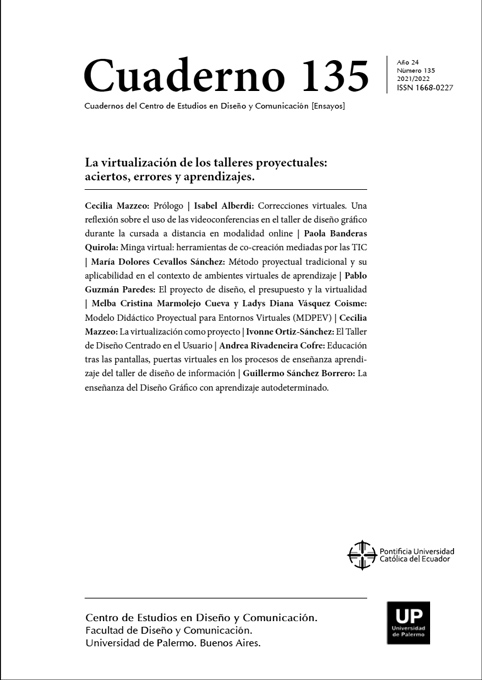Método proyectual tradicional y su aplicabilidad en el contexto de ambientes virtuales de aprendizaje
Abstract
This is a question repeatedly asked since the beginning of the change that took place in the classroom. Regardless of whether it is applicable or not, the answer is that it must necessarily adapt and evolve accordingly. From a projective approach, within the field of Graphic Design, where concrete proposals must develop from a conceptual basis, it is inevitable to work with the projective method in a workshop mode, which requires constant feedback on the project’s progress. This makes sense insofar as it is possible to elucidate advances and corrections on the proposal presented and developed by the student. The mediation of a technology that bridges the distance carries problems, especially when both parties, teacher, and student, are not "there" to discuss the project. Everything is done on a screen. It is not sketched or schematized tangibly or directly. This is aggravated if the class is not given in synchronicity. The proposal is that the ICT adaptation that mediates the process also depends on the adaptation of the teacher's method—emphasizing the new protagonism of the teacher whose identity is nowadays, an omnipresent screen that can be present in all the student's environments. The proposal is to find the core points of a teacher’s resignification as a new image supported by an audiovisual language where the modification of both the pedagogical and attitudinal model in the synchronous and asynchronous meetings can become advantageous within the curricular improvement
References
alatrava (2019). Transformación digital en la educación: blended learning y flipped classroom o aula invertida. Recuperado de https://www.d2l.com/es/blog/transformaciondigital-en-la-educacion-blended-learning-y-flipped-classroom-o-aula-invertida/
De Santiago, P. (2016). El cine en 7 películas: guía básica del lenguaje cinematográfico. Madrid: UNED - Universidad Nacional de Educación a Distancia.
Flip learning (2015). Visión -What is a plipped classroom? Del blog The Flipped classroom. Recuperado de https://www.theflippedclassroom.es/what-is-innovacion-educativa/
Ferrari, M. (2008). Paulo Freire, o mentor da Educação para a consciência. Nova Escola. Recuperado el 08 de abril de 2021, de https://novaescola.org.br/conteudo/460/mentoreducacao-consciencia
García Aretio, L. (Coord.) (2007). De la educación a distancia a la educación virtual. Barcelona: Ariel.
García Perea, M. (Coord.) (2015). Tecnología y Aprendizaje Ubicuo. Toluca: Instituto superior de Ciencias de la Educación.
Narváez Torregrosa, D. (2004). Los inicios del cine. Plaza y Valdés, S.A. de C.V. México.
Rama Vitale, C. (2017). Futuro de los Sistemas y Ambientes Educativos mediados por las TIC. Universidad de Guadalajara, Jalisco.
Los autores/as que publiquen en esta revista ceden los derechos de autor y de publicación a "Cuadernos del Centro de Estudios de Diseño y Comunicación", Aceptando el registro de su trabajo bajo una licencia de atribución de Creative Commons, que permite a terceros utilizar lo publicado siempre que de el crédito pertinente a los autores y a esta revista.


